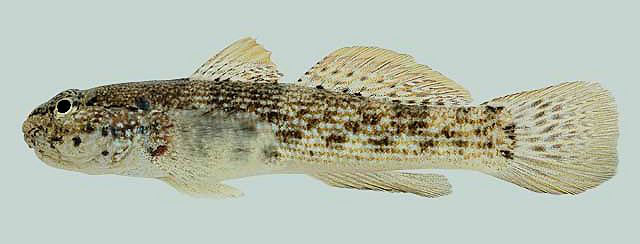| Gobiidae (Gobies), subfamily: Gobiinae |
| 9.4 cm SL (male/unsexed) |
|
benthopelagic; marine |
| Western Atlantic: insular and continental islands in the Caribbean. |
|
Dorsal spines (total): 7-7; Dorsal soft rays (total): 9-9; Anal spines: 1-1; Anal soft rays: 8-8. This species is distinguished by the following characters: 18-21 pectoral fin rays; 38-42 lateral scale rows; upper jaw length 9.5-13 % SL, rarely less than 11% SL; predorsal squamation reaching anteriorly beyond vertical through posterior margin of preopercle, often reaching posterior edge of postorbital blotch; first dorsal fin with 1-4 dark blotches on each element forming 1-4 stripes across fin or with one broad, dark brown longitudinal stripe across middle of fin; ventral portion of trunk with 2 rows of markings, upper row with 7-8 dark blotches along lateral midline from beneath pectoral fin to point just anterior to markings on caudal peduncle, lower row typically consisting of 3 conspicuous dark spots - occasionally with diffuse 4th spot beginning beneath ventral portion of pectoral fin and terminating just anterior to origin of anal fin (Ref. 85559). |
| Collected primarily from reef crests and from shallow tidepools on exposed beaches, where it typically co-occurs with B. mystacium and B. lacertus. A single specimen was collected from a sheltered rocky shoreline near an irrigation canal in Puerto Rico and associated with three species, B. geminatus, B. lacertus, and B. soporator. GenBank accession number for COI sequence of holotype: HM748393 (Ref. 85559). |
|
Least Concern (LC); Date assessed: 01 March 2010 Ref. (130435)
|
| harmless |
|
Source and more info: www.fishbase.org. For personal, classroom, and other internal use only. Not for publication.

